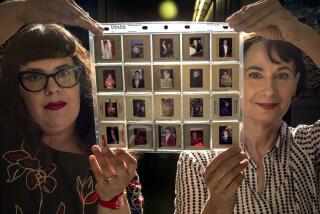The $71.5-Million Sale : ‘This is probably the last Van Gogh self-portrait that will come on the market,’ which explains . . .
- Share via
NEW YORK — After Thursday night’s auction, at which a self-portrait by Vincent Van Gogh was sold for an astounding $71.5 million--the second-highest amount ever paid for a Van Gogh and the third highest for any painting at auction--Christie’s officials offered up a couple of reasons for having placed such a piddling estimate on the painting, a mere $20 million to $25 million.
His last self-portrait to go up for auction, they noted, brought a winning bid of $24 million back in 1989, during the hot market for high-end art. And for all the allure of Van Gogh, the one for sale Thursday night was, well, small: just 16 1/8 inches tall and 12 7/8 inches wide.
So there were gasps from the standing-room crowd in the Park Avenue auction house as the bidding passed $30 million in a snap and a new player entered at $36 million, signaling that the serious action was only beginning. It went on 10 minutes more as the seven original contenders were pared to two, one bidding over the phone, the other through a Christie’s representative on the floor.
Raising each other $1 million at a time, the anonymous pair paused only once, at “61,” before the final agonizing end-game. Christie’s Chairman Christopher Burge gave suitable fair warning--”against the telephone . . . last chance now . . . selling it now”--then finally hammered it to a close at $65 million. With the “premium,” the 10% sales commission, that meant a price of $71.5 million for “Portrait of the Artist Without a Beard.”
While the astonishing sum was still short of the record $82.5 million paid for Van Gogh’s “Portrait of Dr. Gachet” in 1990, Thursday’s sale had the auctioneers talking again about the right painting cracking the $100-million mark before long.
This Van Gogh, “superb but fairly modest in scale . . . made a jolly good run at it,” Burge remarked after the two-hour auction. “If the right work comes out, they will have a go for it.”
The $71.5-million Van Gogh sale was by far the most spectacular auction event since May 1990, when Japanese industrialist Ryoei Saito purchased “Portrait of Dr. Gachet” for $82.5 million and Pierre-Auguste’s painting “At the Moulin de la Galette” for $78.1 million on two successive nights at New York auction houses. Saito’s buying spree marked the pinnacle of the art market, following a period of speculative buying. Prices went wild during the late 1980s as wealthy Japanese collectors and dealers bought art in bulk and an international array of investment-minded novices plunged into the market.
But even as Saito was making big news, the market was beginning to plunge. Many investors who purchased artworks at inflated prices lost confidence in the market and speculators vanished from the auction scene in the early 1990s. At the same time, prospective sellers who could afford to wait for a better climate rarely consigned artworks to auction.
Confidence has been restored and prices have risen gradually during the past few years, but never to the level of 1989-90. Buyers have become much more careful and selective, so only the best or most desirable works tend to bring record prices.
While the Van Gogh was predicted to bring the season’s biggest sum, no one expected the painting to command much more than Christie’s estimate. Earlier in the week, sales of Impressionist, Modern and contemporary art at both Christie’s and Sotheby’s brought substantial returns but hovered just below the auction houses’ low estimates.
In contrast, Thursday night’s auction at Christie’s was lively--and free-spending--from the start, with buyers three times smashing the previous record ($3.9 million) for a work by Belgian Surrealist Rene Magritte. Some of his best-known paintings were among the 14 being sold from the collection of his Belgium-born lawyer, Harry Torczyner. The San Francisco Museum of Modern Art took home the most expensive one, paying $7.1 million for “Personal Effects,” depicting a giant comb and shaving brush against a cloudy sky. Later, an unfinished Cezanne, “The Chateau Noir,” was purchased for $11.5 million by a European dealer.
Novelty and History of the Self-Portrait
But the evening was dominated by the frenzy of bidding for the Van Gogh from the German collection of Jacques Koerfer, the former chairman of BMW, who died in 1991.
Part of the appeal clearly was the novelty of the self-portrait--which shows Van Gogh without his beard--and the history didn’t hurt, either. The troubled artist was said to have painted it in 1889 while in the asylum at St. Remy as a 70th birthday present for his mother, to show her that he was coming along fine.
Nick Maclean, Christie’s chief 19th century expert, said the value undoubtedly was enhanced by the news earlier this year that the National Gallery of Art in Washington had acquired another Van Gogh self-portrait from the estate of Betsey Cushing Roosevelt Whitney.
“Because the Whitney portrait has been given to the National Gallery . . . this one we do believe is probably the last Van Gogh self-portrait that will come on the [open] market,” Maclean said. “It’s also got this fabulous story.
“The next thing we’ve got to find is that $100-million painting,” he added. “It’s got to be out there.”
The Thursday evening auction was not all a record-breaking event, however. A couple of Modigliani portraits failed to bring minimum prices, including one that did not sell after drawing a top bid of $5.5 million, far below the estimate of $8 million to $10 million.
In all, though, 59 of the 68 lots were sold, for a total of $166.7 million.
Of the buyers, 56% were from the U.S., Christie’s said, 35% from Europe, 5% from Latin America, 2% from Asia and 2% other.
As usual, most of the buyers insisted on anonymity. Indeed, the San Francisco museum was the only buyer identified by name in the listing of the evening’s 10 highest prices. In the case of the Van Gogh, the auctioneers would not even say where in the world the beardless self-portrait was headed.
Paul Lieberman reported from New York; Suzanne Muchnic is based in Los Angeles.
More to Read
The biggest entertainment stories
Get our big stories about Hollywood, film, television, music, arts, culture and more right in your inbox as soon as they publish.
You may occasionally receive promotional content from the Los Angeles Times.










